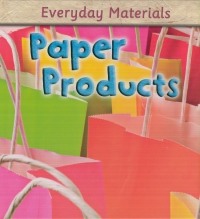| ________________
CM . . .
. Volume XV Number 14. . . .March 6, 2009 
 |
Wool. (Everyday Materials).
Andrew Langley.
St. Catharines, ON: Crabtree, 2009.
24 pp., pbk. & hc., $7.95 (pbk.), $18.36 (hc.).
ISBN 978-0-7787-4138-1 (pbk.), ISBN 978-0-7787-4131-2 (RLB).
Subject Heading:
Wool-Juvenile literature.
Kindergarten-grade 3 / Ages 5-8.
Review by Harriet Zaidman.
** /4
|
| |
|
 |
Glass. (Everyday Materials).
Andrew Langley.
St. Catharines, ON: Crabtree, 2009.
24 pp., pbk. & hc., $7.95 (pbk.), $18.36 (hc.).
ISBN 978-0-7787-4133-6 (pbk.), ISBN 978-0-7787-4126-8 (RLB).
Subject Heading:
Glass-Juvenile literature.
Kindergarten-grade 3 / Ages 5-8.
Review by Harriet Zaidman.
** /4
|
| |
|
 |
Wood. (Everyday Materials).
Andrew Langley.
St. Catharines, ON: Crabtree, 2009.
24 pp., pbk. & hc., $7.95 (pbk.), $18.36 (hc.).
ISBN 978-0-7787-4137-4 (pbk.), ISBN 978-0-7787-4130-5 (RLB).
Subject Headings:
Wood-Juvenile literature.
Wood products-juvenile literature.
Kindergarten-grade 3 / Ages 5-8.
Review by Harriet Zaidman.
** /4
|
| |
|
 |
Metal. (Everyday Materials).
Andrew Langley.
St. Catharines, ON: Crabtree, 2009.
24 pp., pbk. & hc., $7.95 (pbk.), $18.36 (hc.).
ISBN 978-0-7787-4134-3 (pbk.), ISBN 978-0-7787-4127-5 (RLB).
Subject Headings:
Metals-Juvenile literature.
Metal products-Juvenile literature.
Kindergarten-grade 3 / Ages 5-8.
Review by Harriet Zaidman.
** /4
|
| |
|
 |
Plastic. (Everyday Materials).
Andrew Langley.
St. Catharines, ON: Crabtree, 2009.
24 pp., pbk. & hc., $7.95 (pbk.), $18.36 (hc.).
ISBN 978-0-7787-4136-7 (pbk.), ISBN 978-0-7787-4129-9 (RLB).
Subject Heading:
Plastics-Juvenile literature.
Kindergarten-grade 3 / Ages 5-8.
Review by Harriet Zaidman.
** /4
|
| |
|
 |
Paper Products. (Everyday Materials).
Andrew Langley.
St. Catharines, ON: Crabtree, 2009.
24 pp., pbk. & hc., $7.95 (pbk.), $18.36 (hc.).
ISBN 978-0-7787-4135-0 (pbk.), ISBN 978-0-7787-4128-2 (RLB).
Subject Headings:
Paper products-Juvenile literature.
Paper-Juvenile literature.
Papermaking-Juvenile literature.
Kindergarten-grade 3 / Ages 5-8.
Review by Harriet Zaidman.
** /4
|
| |
|

excerpt:
Fleeces are often dirty with thorns and mud from the fields. They contain a natural grease called lanolin. Lanolin makes the fleece waterproof. The fleeces need to be sorted before they can be used. (From Wool.)
Young children are inquisitive about the world around them. Knowledge learned early can stick for a lifetime, and childhood interest can also lead to an occupation as an adult. Books about the everyday things that surround us are a perfect way to introduce children to information and science – precursors to more in-depth topics, such as chemistry and physics that explain the composition and performance of these everyday materials. That's why it's so disappointing when books appear to have promise but fail to live up to their billing.
The books in the "Everyday Materials" series, published by Crabtree and written by Andrew Langley, explain where materials such as wool and plastic come from, how they are manufactured and how they are used. The books do provide basic information, but they could contain many more facts without overwhelming children from the targeted age group. The production of the entire series also indicates a need for a clearer link between text and pictures to be of educational value.
Simple does not have to mean simplistic, and even a child would be bored by an entire quarter page devoted to writing, in big letters "Metal machines even printed this book." (Metal) or "Can you find any paper on a roll in your home?" (Paper Products) Large colour pictures are nice to look at, but they are not a substitute for information, which is why a child would seek out a nonfiction book.
The quality of explanation is uneven and is not clarified by the photographs. In Paper Products, the text reads: "The wet pulp comes out of the tank and is spread on wire mesh. Huge rollers squeeze the water out of the pulp. The water drains away through the holes in the wire mesh." A giant machine with something white in its midst is pictured. No wire mesh is visible. An adult might be able to figure out the logic of paper production, but not many children have toured industrial enterprises and understand how they work. The photographs should have been chosen more judiciously, and, if there were no pictures that accurately represented the text, then a labeled drawing should have been commissioned.
A teacher's direction would be needed for a child to get the most from these titles. The 24-page books are divided into two-page chapters. They have one page of questions based on the text as well as a page with a web that relates the topic of the book to curriculum areas, although the connections are thin. For example, in Paper Products, the connection to the English curriculum is "All the books you read are printed on paper. Read The Paper Bag Princess by Robert Munsch. She has to wear a paper bag when a dragon burns all her clothes!" One page contains a glossary of bolded words, although most of these words should have been explained within the body of the book. A child should not have to turn to the back of the book to learn that fleece is "The whole wool coat of a sheep" (Wool). A list of books and websites is followed by an index.
A teacher might use these books as a resource in the classroom, but overall this series is weak. It is not a must-buy for a library or classroom collection.
Recommended with reservations.
Harriet Zaidman is a teacher-librarian in Winnipeg, MB.

To comment
on this title or this review, send mail to cm@umanitoba.ca.
Copyright © the Manitoba Library Association. Reproduction for personal
use is permitted only if this copyright notice is maintained. Any
other reproduction is prohibited without permission.
NEXT REVIEW |
TABLE OF CONTENTS FOR THIS ISSUE
- March 6, 2009.
AUTHORS |
TITLES |
MEDIA REVIEWS |
PROFILES |
BACK ISSUES |
SEARCH |
CMARCHIVE |
HOME |





